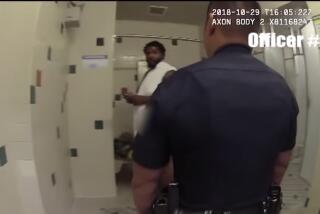Golf Thinks it Lost to Martin
After the judge, U.S. Magistrate Thomas Coffin, made his decision, said that Casey Martin was allowed to chase after his golf dreams in a slow-moving golf cart, Martin stood good and tall behind the microphones, stood as strong as he could on a right leg that is as sturdy as a swizzle stick.
For this one moment, the face of golf was not Martinâs old Stanford teammate, Tiger Woods. The face of golf was Martin. In victory, only his voice was as weak as his leg.
âIâm sorry for the emotion part,â he said. âBut that happens when I stand in front of people.â
At least he was still standing. Someday he may not be, because he is as likely to lose his lower right leg as keep it. The PGA Tour fought him into this courtroom in Oregon anyway, and probably will try to fight him all the way to the Supreme Court to protect its rules about its players having to walk. They looked like insensitive and bigoted fools in doing it.
But then golf has been bigoted and closed-minded before, about almost everything. Blacks. Women. Change, mostly.
Casey Martin busted another window in golf, let a little more air in. You watched him afterward on television, watched him do interview after interview, and you knew that no one would ever again think that you have to walk to your ball in golf -- the way Ben Hogan did after his car accident, the way Ken Venturi did at the U.S. Open of 1964 -- to be brave and tough or some kind of hero.
Casey Martin is as tough as anybody to ever come along in golf in my lifetime. Period. As tough as Hogan. As tough as Venturi. They didnât retire the trophy for heart, or spirit. The PGA Tour, led by commissioner Tim Finchem, kept saying this was not about Martin, it was about preserving the integrity of the competition. Finchem sounded like just another old gasbag sitting on the veranda. So did Arnold Palmer and Jack Nicklaus and Venturi, all of whom lined up against Martin, on the side of the silly mythology of golf, one that says that the whole thing isnât pure if you donât walk.
They still want you to believe that golf is some sort of grueling obstacle course in khaki slacks and spikeless shoes, the walking as crucial to everything as distance, shotmaking, the ability to make a four-foot putt in the heat. It is a notion you can shoot out of a cannon now, along with Finchem and his lawyers.
Q: Why do we have to do things this way?
A: Because we always have, thatâs why!
The case wasnât about about Casey Martin? These Tour guys really do sound as if theyâre drunk, maybe on all their old-boy, old-school rhetoric. It was about him from the start. The judge saw that with great clarity, saw the Americans With Disabilities Act with extreme clarity, even if the Tour did not. Does not.
After it was over, Martin said, âI hope five to 10 years from now, if Iâm still able to play, the PGA will look back on this and say, âWhyâd we fight this guy?ââ
They are too stubborn for that, obsessed with their own silly deceit that golfers are as athletic as cornerbacks, even with all the slobs you see out there getting rich.
I heard somebody on The Golf Channel last night say that Martin wasnât looking for a competitive edge, just for an even playing field. Take a look at Martinâs right leg sometime. If you can take it. Then decide how even the playing field is for him, with or without a cart. I hope he is playing in 10 years. More, I hope he has two legs.
I have played golf since I was 8 and have a handicap lower than that. That isnât a resume, just context. I love so much of golfâs history, so many of its traditions. And there isnât a player I have ever known who wants to be in a cart when he could be walking.
Casey Martin would rather be walking through life instead of hobbling. He wakes up with pain and goes to bed with pain and in between manages to make his golf game work on his swizzle-stick leg. While he still has that leg.
You donât appeal a decision that lets a guy like that into your club. You cheer it. Any- body who doesnât understand why golf won should have to walk a mile in Casey Martinâs golf shoes. Or maybe just to the cart and back.
More to Read
Go beyond the scoreboard
Get the latest on L.A.'s teams in the daily Sports Report newsletter.
You may occasionally receive promotional content from the Los Angeles Times.










